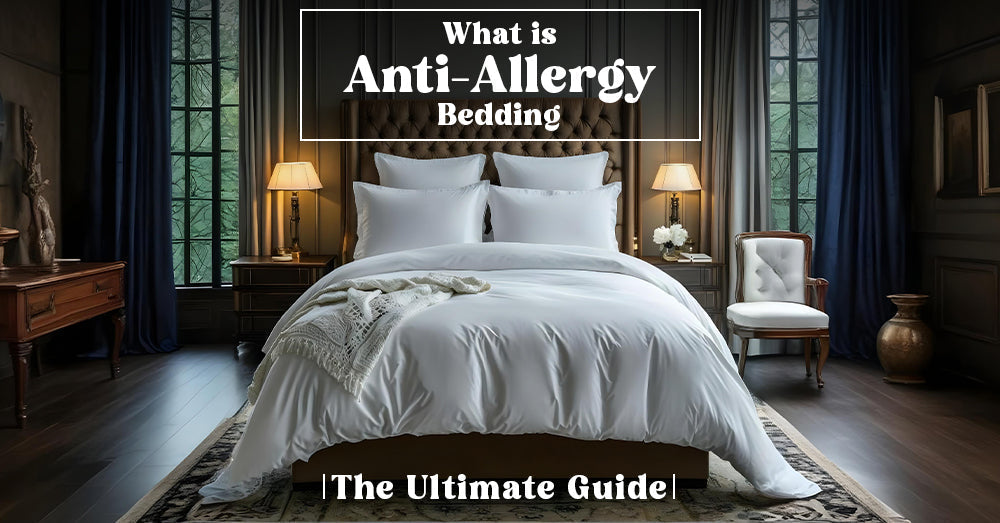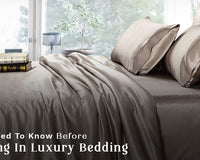If you’ve ever woken up with a runny nose, itchy eyes, or that dreaded tickle in your throat, then you’re not alone. Allergies can turn your cosy bed into a night-time battleground. But what if your bedding could be part of the solution rather than the problem? Enter anti-allergy bedding – the unsung hero in the fight against night-time allergens.
In this ultimate guide, we'll dive into everything you need to know about anti-allergy bedding. Whether you're an allergy sufferer looking for relief or someone curious about how to create a healthier sleep environment, this guide is packed with insights, tips, and answers to your burning questions. So, let’s get started!
What Exactly is Anti-Allergy Bedding?

Anti-allergy bedding is designed to reduce your exposure to allergens, especially while you sleep. But what makes it different from regular bedding?
Anti-allergy bedding is crafted from materials that either resist allergens or prevent them from accumulating. This type of bedding usually comes with specialised treatments or tightly woven fabrics that block out common allergens such as dust mites, pet dander, and pollen.
You might be wondering: Isn't all bedding designed to be clean and safe? While regular bedding can certainly be comfortable and aesthetically pleasing, it often lacks the specific properties needed to combat allergens effectively. Anti-allergy bedding, on the other hand, is engineered with your health in mind.
Why Do You Need Anti-Allergy Bedding?
If you or someone in your household suffers from allergies or asthma, anti-allergy bedding can make a world of difference. Dust mites, pet dander, and pollen are some of the most common allergens that love to settle into your bedding. These microscopic invaders can trigger allergic reactions, making it harder for you to get a restful night’s sleep.
So, why put up with restless nights and morning sneezes when you can invest in single bedding that works to keep allergens at bay? With anti-allergy bedding, you're not just improving your sleep quality; you're also creating a healthier environment.
Common Allergens Lurking in Your Bedding
Before diving into how anti-allergy bedding works, let’s identify the usual suspects lurking in your bedding:
-
Dust Mites: These tiny creatures are the most common cause of allergies. They feed on dead skin cells and thrive in warm, humid environments like your bed.

-
Pet Dander: Even if your furry friend doesn’t sleep in your bed, their dander can still make its way into your bedding.

- Pollen: These fine particles can hitch a ride into your home and settle into your bedding, causing sneezing and congestion.
-
Mould Spores: If your bedding isn’t properly aired out or washed, it can become a breeding ground for mould.

How Does Anti-Allergy Bedding Work?
You might be curious: How does anti-allergy bedding actually stop allergens? The secret lies in the materials and treatments used in these products.

- Tightly Woven Fabrics: Anti-allergy bedding often uses fabrics with a tight weave that prevents dust mites and other allergens from penetrating. This means that even if there are allergens in your environment, they won’t be able to get into your bedding.
- Hypoallergenic Fillings: Pillows, duvets, and mattresses are often filled with hypoallergenic materials that resist allergens. Synthetic fibres, for example, are less likely to harbour dust mites compared to natural down.
- Anti-Microbial Treatments: Some anti-allergy bedding is treated with anti-microbial agents that inhibit the growth of mould, bacteria, and dust mites. This treatment can add an extra layer of protection against allergens.
- Easy-to-Wash Materials: Bedding that’s easy to wash at high temperatures is another key feature. Washing at 60°C or higher can effectively kill dust mites and remove allergens.
Types of Anti-Allergy Bedding
When it comes to anti-allergy bedding, you’ve got options! Let’s explore the various types of bedding that can help you create a healthier sleep environment.
1. Anti-Allergy Pillows

Pillows are often the biggest culprit when it comes to harbouring allergens. Anti-allergy pillows are made from hypoallergenic materials like memory foam or synthetic fibres that resist dust mites and mould.
But how do you choose the right one? Consider your sleep position. Are you a side sleeper, back sleeper, or stomach sleeper? The right anti-allergy pillow and pillowcases should provide support while keeping allergens at bay.
2. Anti-Allergy Duvets

Your duvet is another hotspot for dust mites. Anti-allergy 15 duvet tog single are designed with hypoallergenic fillings and tightly woven covers that create a barrier against allergens.
Wondering whether you need a lightweight or heavyweight duvet? Choose based on your climate and personal preference, but always opt for one that’s easy to wash to keep allergens under control.
3. Anti-Allergy Mattress Protectors

A mattress protector is your first line of defence against allergens in your mattress. Anti-allergy extra deep mattress protectors are designed to encase your mattress protector and block out allergens. They’re usually waterproof as well, protecting your mattress from spills and stains.
When shopping for a waterproof mattress protector, look for one with a tight weave and anti-microbial treatment for maximum protection.
4. Anti-Allergy Sheets and Pillowcases

These are your everyday bedding essentials. Anti-allergy sheets and pillowcases are made from materials like microfibre or cotton with a high thread count, which can help keep allergens at bay.
What’s the best way to care for your anti-allergy sheets? Wash them regularly at a high temperature and dry them thoroughly to prevent mould and dust mites from taking hold.
Benefits of Anti-Allergy Bedding
So, what’s in it for you? Let’s break down the top benefits of anti-allergy bedding.
- Improved Sleep Quality: With fewer allergens in your bed, you’re less likely to wake up sneezing, coughing, or itching. This means more restful nights and better overall sleep quality.
- Healthier Environment: Anti-allergy bedding helps create a cleaner and healthier environment by reducing the presence of allergens that can trigger respiratory issues.
- Longer-Lasting Bedding: Anti-allergy bedding is often more durable than regular bedding. The materials used are designed to withstand regular washing at high temperatures, ensuring that your bedding stays fresh and allergen-free for longer.
- Peace of Mind: Knowing that your bedding is working to protect you from allergens can provide peace of mind, especially if you or a loved one suffers from allergies or asthma.
How to Choose the Best Anti-Allergy Bedding?
Choosing the right anti-allergy bedding can feel overwhelming with so many options available. Here are some tips to help you make the best choice:

- Check the Labels: Look for bedding that’s specifically labelled as anti-allergy or hypoallergenic. Designed with allergy sufferers in mind, this ensures that the product is safe for use.
- Consider the Fillings: If you have a specific allergy, be mindful of the fillings. For example, if you’re allergic to feathers, opt for synthetic fillings instead.
- Think About Maintenance: How easy is it to clean your bedding? Opt for products that can be washed at high temperatures to kill dust mites and remove allergens effectively.
- Look for Certifications: Bedding with certifications such as OEKO-TEX or Allergy UK’s Seal of Approval can give you added confidence that the product meets certain standards for allergy protection.
- Don’t Forget Comfort: While protection from allergens is crucial, comfort should never be compromised. Ensure your bedding provides the right level of support and warmth for your needs.
Final Thoughts: Is Anti-Allergy Bedding Worth It?
If you’re tired of waking up feeling congested and sniffly, or if you’re simply looking to create a healthier sleep environment, anti-allergy bedding is definitely worth considering. It’s an investment in your health and well-being that can pay off with better sleep and fewer allergy symptoms.
Remember, the key to success with anti-allergy bedding is consistency. Regular washing, a clean bedroom environment, and the right products can work together to reduce allergens and help you enjoy a restful, sneeze-free sleep.
So, why not give anti-allergy bedding a try? It could be the simple change you need to transform your nights – and your mornings. Sleep tight!
FAQs
-
Can anti-allergy bedding eliminate allergies?
Anti-allergy bedding can significantly reduce your exposure to allergens, but it may not eliminate allergies. It’s essential to maintain a clean bedroom environment by regularly washing your bedding and keeping dust and pet dander to a minimum.
- How often should I wash my anti-allergy bedding?
It’s recommended to wash your bedding at least once a week. If you suffer from severe allergies, consider washing pillowcases and sheets more frequently.
-
Can I use anti-allergy bedding even if I don’t have allergies?
Absolutely! Anti-allergy bedding isn’t just for allergy sufferers. It can help anyone create a cleaner, more hygienic sleep environment.
-
Is anti-allergy bedding more expensive than regular bedding?
Anti-allergy bedding can be slightly more expensive than regular bedding, but the health benefits and durability often make it worth the investment.


